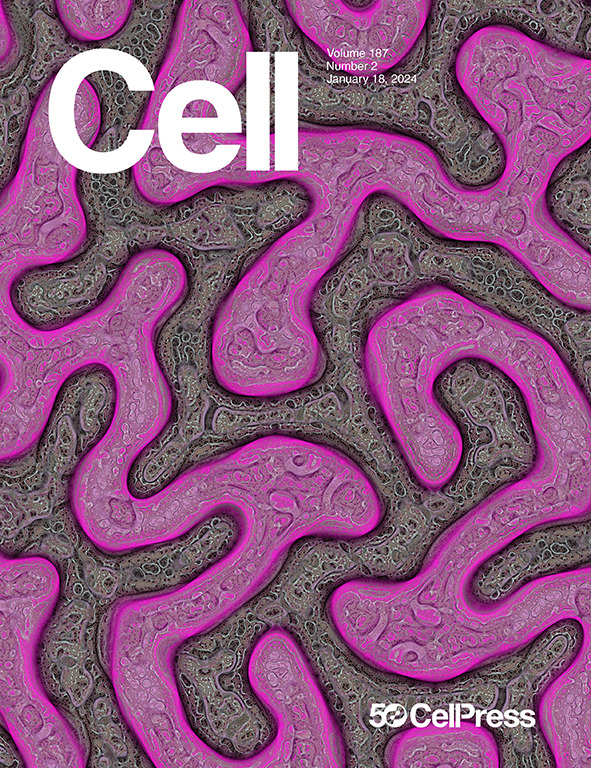神经内分泌细胞通过沙漠刺猬信号调控再生
IF 45.5
1区 生物学
Q1 BIOCHEMISTRY & MOLECULAR BIOLOGY
引用次数: 0
摘要
了解哺乳动物再生的机制可能有助于开发新的再生疗法。我们提出了一种机制,其中从上皮神经内分泌细胞分泌的沙漠刺猬(Dhh)引起间充质细胞的再生/保护反应。在哺乳动物气道中,这种间充质反应显著地放大了来自罕见神经内分泌细胞的初始信号,以激活整个组织,以便在吸入二氧化硫气体或感染流感或SARS-CoV-2后存活和再生。类似的由神经内分泌β细胞Dhh引导的上皮-间充质反馈(EMF)信号同样保护小鼠胰岛免受链脲佐菌素(STZ)损伤。使用Hedgehog通路抑制剂治疗的患者糖尿病发病率较高,这表明EMF信号在人胰岛中的作用。值得注意的是,通过小分子Hedgehog通路激动作用增强EMF可以保护胰腺β细胞免受STZ损伤,并保护SO2和流感感染引起的气道损伤,在化学或感染性气道损伤和糖尿病中具有潜在的保护/治疗作用。本文章由计算机程序翻译,如有差异,请以英文原文为准。

Neuroendocrine cells orchestrate regeneration through Desert hedgehog signaling
Understanding the mechanisms underlying mammalian regeneration may enable development of novel regenerative therapies. We present a mechanism wherein Desert hedgehog (Dhh), secreted from epithelial neuroendocrine cells, elicits a regenerative/protective response from mesenchymal cells. In mammalian airway, this mesenchymal response strikingly amplifies the initial signal from rare neuroendocrine cells to activate the entire tissue for survival and regeneration upon injury from SO2 gas inhalation or following influenza or SARS-CoV-2 infection. Similar epithelial-mesenchymal feedback (EMF) signaling directed by Dhh from neuroendocrine β cells likewise protects mouse pancreatic islets from streptozotocin (STZ) injury. A role for EMF signaling in human pancreatic islets is suggested by higher incidence of diabetes in patients treated with Hedgehog pathway inhibitors. Remarkably, EMF augmentation by small-molecule Hedgehog pathway agonism protects against STZ injury of pancreatic β cells and shields against airway injury from SO2 and influenza infection, with potential protective/therapeutic utility in chemical or infectious airway injury and in diabetes.
求助全文
通过发布文献求助,成功后即可免费获取论文全文。
去求助
来源期刊

Cell
生物-生化与分子生物学
CiteScore
110.00
自引率
0.80%
发文量
396
审稿时长
2 months
期刊介绍:
Cells is an international, peer-reviewed, open access journal that focuses on cell biology, molecular biology, and biophysics. It is affiliated with several societies, including the Spanish Society for Biochemistry and Molecular Biology (SEBBM), Nordic Autophagy Society (NAS), Spanish Society of Hematology and Hemotherapy (SEHH), and Society for Regenerative Medicine (Russian Federation) (RPO).
The journal publishes research findings of significant importance in various areas of experimental biology, such as cell biology, molecular biology, neuroscience, immunology, virology, microbiology, cancer, human genetics, systems biology, signaling, and disease mechanisms and therapeutics. The primary criterion for considering papers is whether the results contribute to significant conceptual advances or raise thought-provoking questions and hypotheses related to interesting and important biological inquiries.
In addition to primary research articles presented in four formats, Cells also features review and opinion articles in its "leading edge" section, discussing recent research advancements and topics of interest to its wide readership.
 求助内容:
求助内容: 应助结果提醒方式:
应助结果提醒方式:


